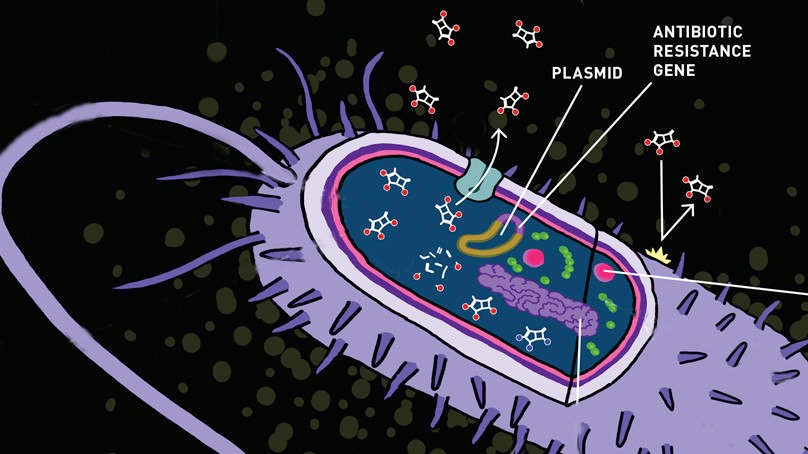AMAZING BIOLOGY CHRONICLES: SUPERBUGS
Our species is quite elusive to total destruction, however, human adaptability is nothing compared to bacteria, viruses, parasites, and fungi. Mostly due to their high rate of reproduction, these organisms have the ability to adapt very quickly to new environmental pressures (1).
Although some bacteria species are helpful and even critical for our survival, such as the bacteria found in our digestive system, many bacteria are capable of harming us. Since the 1940s, we have had the capacity to kill these microbes, and save many people’s lives (2). Unfortunately, one unintended consequence of this tool is the emergence of superbugs (2).
Superbugs are microbes which are resistant to our methods of destruction and control, and these microbes are not limited to only bacteria (1). We have also tried to kill and control certain fungi which has lead to the emergence of Candida Aurus, a yeast which is resistant to most major anti microbial medications (3). Parasites like mosquitoes, ticks, and worms can also develop immunity against our best medications (1).
There are two main theories about why these superbugs are emerging. The first is the misuse of antibiotics in the home. After a bacterial, fungal, or parasitic infection, many people stop taking their prescribed antibiotics once they start to feel better. When they do this, only the most resistant organisms remain, and those will multiply to create a new generation of organisms which are more resistant that the first generation. It works similarly in modern agricultural systems. When fungicides are applied to crops incorrectly, or antibiotics are fed to livestock consistently to improve feed rates, only the most resistant microbes will continue to survive. These resistant bugs could be either harmful or harmless, and there is no way to control which ones will survive. That is why it is very important to have strict regulation of these substances, to only allow certified professionals to handle these substances, follow antibiotic/antifungal application instructions correctly, and to only use antibiotics only in serious cases of infection. (2)
Interestingly, this mechanism of selection does not necessarily select bugs which are “stronger”, but actually selects microbes which produce large amounts of a certain enzyme which neutralizes the antibiotic and protects the microbe (1). This process occurs to due small organelles within each cell called “transmissible plasmids” (1). These small proteins are separate from the genetic code of the cell, and can quite easily be transferred between organisms (1). If you want to understand more about how this phenomenon occurs, you can watch this YouTube video: https://youtu.be/gu6WZ3EreWs, or speak with Dr. Tran Thi Thuy, the head of the department of Biotechnology and Microbiology. She also has a list of all available classes which relate to this important and ever-changing field of study.
Sources:
Encyclopedia Britanica (2020) APA citation. Evolution of Bacteria. Retrieved from https://www.britannica.com/science/bacteria/Evolution-of-bacteria
NIH-News in Health (2014, February) APA citation. Stop the Spread of Superbugs: Help Fight Drug-Resistant Bacteria. Retrieved from https://newsinhealth.nih.gov/2014/02/stop-spread-superbugs
Pappas, S. (2019, April) APA citation. Deadly Fungal “Superbug” Spreads Worldwide, Alarming Scientists. Retrieved from https://www.livescience.com/65181-candida-auris-spreading.html

Images sources:
- https://www.google.com/search?q=superbugs&rlz=1C9BKJA_enUS757US757&hl=en-US&prmd=inv&sxsrf=ALeKk03cVB9_N4uI-KcPwH-VpXWfWncalA:1588837739065&source=lnms&tbm=isch&sa=X&ved=2ahUKEwi0rqvooaHpAhXIP3AKHTj_AwUQ_AUoAXoECA4QAQ&biw=1366&bih=915&dpr=2#imgrc=DUAEeCJaOtcQtM
- https://www.google.com/search?q=superbugs&rlz=1C9BKJA_enUS757US757&hl=en-US&prmd=inv&sxsrf=ALeKk03cVB9_N4uI-KcPwH-VpXWfWncalA:1588837739065&source=lnms&tbm=isch&sa=X&ved=2ahUKEwi0rqvooaHpAhXIP3AKHTj_AwUQ_AUoAXoECA4QAQ&biw=1366&bih=915&dpr=2#imgrc=WG_5X7ILiemb0M